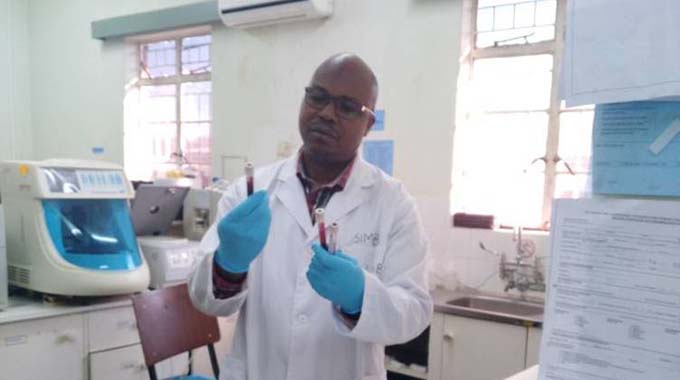Decentralising HIV diagnosis bears fruits

Paidamoyo Chipunza Senior Health Reporter—
“We can now more easily switch our clients from one drug to another. Once a client walks into our institution, we can quickly check for their viral load count level and take necessary intervention immediately,” says Leonard Nyakabau, a nurse and HIV focal person for Hauna district hospital in Manicaland.
He said previously, they were losing some patients as the disease progressed while awaiting viral load confirmation from a centralised laboratory.
It took up to three months to get that confirmation.
Mr Nyakabau said a person living with HIV cannot be switched from one drug to another without knowing their viral load status despite them presenting with opportunistic infections.
Hauna is one of the 25 resource- constrained district hospitals in the country that benefited from the 100 Samba point of care machines used for viral load testing and early infant diagnosis (EID) under a Government decentralisation project launched early this year.
Manufactured by Diagnostics for the Real World (DRW), a spinout company from Cambridge University and funded by the Global Fund to Fight Aids, Tuberculosis and Malaria, the new Samba II point-of-care machines are specifically developed for resource limited settings.
Before rolling out of the first phase of the decentralisation project, institutions such as Hauna district hospital would send their blood samples to a centralised laboratory in Mutare where they took up to three months before being returned, impacting negatively on treatment outcomes as some clients were lost to follow ups or death.

Mr Patrick Simbi running tests on the Samba 11 point of care machines at Hauna district hospital
Hauna district medical officer, Dr Caephas Fonte said this arrangement resulted in high volumes of sample rejections, lost samples and ultimately delayed treatment thereby compromising effective HIV management.
He said samples have a timeframe that they should be processed within before they are rendered useless and when the timeframe is exceeded, the samples will can no longer be useful.
Dr Fonte said because of transport challenges, some samples took time to reach the central laboratory resulting in rejections.
He also said for Hauna, all samples from the 21 clinics in the district were first transported to the district hospital, from which they would be conveyed to Mutare for processing. In Mutare, he said the samples would be processed together with samples from seven other districts in the province- thereby increasing chances of delay or getting lost.
“We are supposed to be doing routine viral load testing, ideally after every six months and those that seem to be failing we usually do testing again after every three months and that should be associated with adherence counselling,” said Dr Fonte.
“However, because of associated delays with getting samples to Mutare, many samples were getting lost on the way or were rejected resulting in further delays to offer alternative treatment to patients,” he said.
Dr Fonte said with decentralisation of viral load testing, they can now do routine testing and offer necessary interventions in a more timely manner.
He said a reading of less than 1000 copies indicate the person is responding well to treatment while a reading of more than 1000 copies means the person is may be failing antiretroviral drugs and might will need to be counseled, retested and ultimately switched to another drug regimen.
“Right now I have three patients admitted, they are all HIV positive. They came with different conditions and faced with such a scenario one question that comes to mind is, are we failing on ART, what could be the problem.

An array of Samba 11 point of care machines in Hauna district laboratory
“However, we did viral load tests on the three and two of them had viral load of less than 1000 copies meaning they are doing well on ART, so what they are having could just be one of those infections which anyone can have and we are managing them.. However the other one has a viral load of over 1000 copies and we are beginning to ask questions around adherence to medication or whether he could have developed drug resistant HIV. This has all been possible with this decentralisation programme. Previously it would take us up to three months to make such determinations,” said Dr Fonte.
He said furthermore, every pregnant woman who is HIV positive, is supposed to get a viral load check to manage vertical transmission of HIV to her unborn baby.
“A pregnant woman’s viral load is important in classifying a child as a high risk or just a risk baby. Just a risk baby is given nevirapine prophylaxis and a high risk baby is given a dual combination so we need to make that decision because it makes prevention of mother to child transmission (PMTCT) more successful,” said Dr Fonte.
He said Government should actually distribute more Samba machines to the districts to meet the high demand of samples coming from clinics as it was contributing to successful HIV management.
Hauna district hospital medical laboratory scientist Mr Patrick Simbi described the machines as ideal for resource constraint countries like Zimbabwe in managing HIV.
Mr Simbi said when they started using the machines, they ran comparative tests between the point of care machines and the centralised machines and results compared very well.
“All the samples we sent to Mutare for confirmatory results matched with results produced by the point of care machines. What was invalid here was also invalid there. What was below a 1000 copies here was also less than a 1000 copies there.
“However, the advantage of Samba machines is that they produce results on the same day in less than two hours, unlike the previous system where results would take several weeks before they are returned,” said Mr Simbi.
He said on a daily basis, they process an average of 12 samples, giving a maximum of about 250 samples a month.
Mr Simbi said the point of care machines were the way to go and should be cascaded to all clinics to ensure even hard to reach sites benefit from the service.
He also called on Government to quickly implement early infant diagnosis (EID) – a test that is run by the same machine to determine the HIV status of an exposed baby.
Mr Simbi said this service was also much needed but was still not available because of lack of reagents to run it, resulting in samples for EID being sent to central laboratories , where they also take a long time before they are returned.
“We also need to do EID on Samba as a matter of urgency because of these issues of missing results and rejections of samples. You will find that with EID, from each batch we send for processing, we miss a result and considering the fact that, that patient would have waited for almost two months, it then complicates effective management of paediatrics,” said Mr Simbi.
Before the decentralisation project, infant HIV diagnosis was limited to central laboratoriesin Harare, Bulawayo and Mutare. The machines used at these laboratories are big and required skilled manpower and enough space, which could not be found in smaller health institutions at district levels.
Director for Laboratory Services in the Ministry of Health and Child Care Mr Douglas Mangwanya said decentralisation of viral load testing has impacted positively on HIV treatment outcomes.
He said previously, with the centralised system, the number of people living with HIV who accessed viral load testing stood at 15 percent but has now gone up to 70 percent.
Mr Mangwanya said because of this success, Government is now looking forward to go into the second phase of this decentralisation targeting more district hospitals in the country.
He said they are also working on expanding early infant diagnoses to all district hospitals currently offering viral load testing.
“The National Aids Council is working on procurement of the reagents for early infant diagnoses and once these are available, delays encountered in diagnosing exposed babies would be a thing of the past,” said Mr Mangwanya.
According to the Ministry of Health and Child Care, slightly above 50 percent of children with HIV are on treatment and challenges in the diagnosies of the children was one of the reasons cited for the low uptake of paediatric treatment.
Similarly, a number of people living with HIV are failing to get viral load tests on time due to few testing machines, a situation that also complicates tracking of progress to treatment in line with national targets of ensuring that all those on treatment have their viral load suppressed to undetectable levels.









Comments